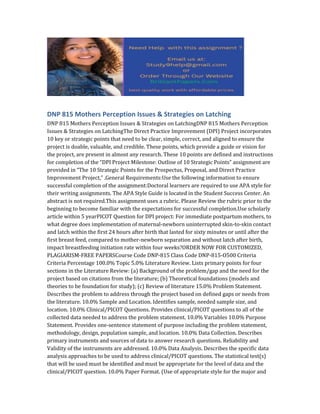
DNP 815 Mothers Perception Issues Strategies on Latching.docx
- 1. DNP 815 Mothers Perception Issues & Strategies on Latching DNP 815 Mothers Perception Issues & Strategies on LatchingDNP 815 Mothers Perception Issues & Strategies on LatchingThe Direct Practice Improvement (DPI) Project incorporates 10 key or strategic points that need to be clear, simple, correct, and aligned to ensure the project is doable, valuable, and credible. These points, which provide a guide or vision for the project, are present in almost any research. These 10 points are defined and instructions for completion of the “DPI Project Milestone: Outline of 10 Strategic Points” assignment are provided in “The 10 Strategic Points for the Prospectus, Proposal, and Direct Practice Improvement Project,” .General Requirements:Use the following information to ensure successful completion of the assignment:Doctoral learners are required to use APA style for their writing assignments. The APA Style Guide is located in the Student Success Center. An abstract is not required.This assignment uses a rubric. Please Review the rubric prior to the beginning to become familiar with the expectations for successful completion.Use scholarly article within 5 yearPICOT Question for DPI project: For immediate postpartum mothers, to what degree does implementation of maternal-newborn uninterrupted skin-to-skin contact and latch within the first 24 hours after birth that lasted for sixty minutes or until after the first breast feed, compared to mother-newborn separation and without latch after birth, impact breastfeeding initiation rate within four weeks?ORDER NOW FOR CUSTOMIZED, PLAGIARISM-FREE PAPERSCourse Code DNP-815 Class Code DNP-815-O500 Criteria Criteria Percentage 100.0% Topic 5.0% Literature Review. Lists primary points for four sections in the Literature Review: (a) Background of the problem/gap and the need for the project based on citations from the literature; (b) Theoretical foundations (models and theories to be foundation for study); (c) Review of literature 15.0% Problem Statement. Describes the problem to address through the project based on defined gaps or needs from the literature. 10.0% Sample and Location. Identifies sample, needed sample size, and location. 10.0% Clinical/PICOT Questions. Provides clinical/PICOT questions to all of the collected data needed to address the problem statement. 10.0% Variables 10.0% Purpose Statement. Provides one-sentence statement of purpose including the problem statement, methodology, design, population sample, and location. 10.0% Data Collection. Describes primary instruments and sources of data to answer research questions. Reliability and Validity of the instruments are addressed. 10.0% Data Analysis. Describes the specific data analysis approaches to be used to address clinical/PICOT questions. The statistical test(s) that will be used must be identified and must be appropriate for the level of data and the clinical/PICOT question. 10.0% Paper Format. (Use of appropriate style for the major and
- 2. assignment) 5.0% Documentation of Sources. (citations, footnotes, references, bibliography, etc., as appropriate to assignment and style) 5.0% Total Weightage 100% Assignment Title “DPI Project Milestone: Outline of 10 Strategic Points” Revision Not Present (0.00%) Item is not present. Item is not present. Item is not present. Item is not present. Item is not present. Item is not present. Item is not present. Item is not present. Item is not present. Template is not used appropriately or documentation format is rarely followed correctly. Sources are not documented. Total Points 50.0 Does Not Meet Expectations (74.00%) ot all components are present. Large gaps are present in the components that leave the reader with significant questions.